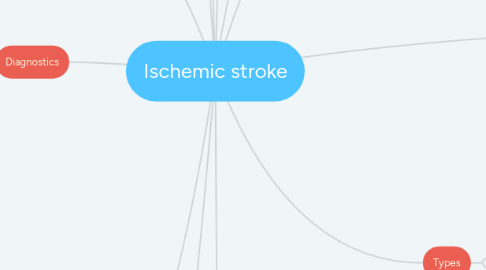
1. Definition
1.1. a type of stroke that occurs when the flow of blood to the brain is blocked
2. Diagnostics
2.1. CT scan
2.1.1. within 25 min to determine type of stroke
2.2. MRI
2.3. MR angiography of brain & neck vessels
2.4. Rule out / Assess for other complications
2.4.1. 12-lead EKG
2.4.2. carotid ultrasound
2.4.3. CT angiography
2.5. Transcranial Doppler flow
2.6. transthoracic/transesophageal echocardiography
3. Expected treatments
3.1. Thrombolytic Therapy
3.1.1. Dissolves clot
3.1.2. Goal is administer to within 60min of admission to ED
3.1.3. Side effects
3.1.3.1. Bleeding
3.2. Endovascular Therapy
3.2.1. Criteria
3.2.1.1. 18yrs or older
3.2.1.2. NIHSS score greater than 6
3.2.1.3. ASPECT score greater than 6
3.2.1.4. receving IV t-Pa within 4.5 hrs of onset
3.2.1.5. Causative occlusion
3.2.1.6. Prestroke status of no deficits
3.3. Anticoagulant administration
3.3.1. Heparin
3.3.2. LMWH
3.3.3. Warfarin
3.3.3.1. INR between 2-3
3.3.4. Newer antigcoagulants
3.3.4.1. dabigatran
3.3.4.2. apixban
3.3.4.3. edoxaban
3.3.4.4. rivaroxban
3.3.5. IF contraindicated
3.3.5.1. Aspirin
4. Common nursing diagnosis
4.1. Impaired physical mobility
4.2. Acute pain
4.3. Risk for impaired skin integrity
4.4. Risk for Impaired Swallowing
4.5. Risk for Injury
4.6. Impaired Verbal Communication
4.7. Disturbed Sensory Perception
5. Interprofessional team members
5.1. neurologist
5.2. neuroradiologist
5.3. radiology department
5.4. laboratory technicians
5.5. pharmacy
5.6. Provider
5.7. speech pathologist
6. New vocab
6.1. Dysarthria
6.1.1. Weakness in the muscles used for speech
6.2. Aphasia
6.2.1. inability to understand/express language
6.2.1.1. Expressive
6.2.1.2. Receptive
6.2.1.3. Mixed?
6.2.1.4. Global
6.3. HEMI
6.3.1. -plegia
6.3.1.1. paralysis
6.3.2. --paresis
6.3.2.1. weakness
6.4. Homonymous hemianopsia
6.4.1. loss of half of vision
7. Types
7.1. Large artery thrombotic strokes
7.1.1. Caused by
7.1.1.1. atherosclerotic plaques
7.1.2. S/S
7.1.2.1. ischemia and infarction
7.2. small penetrating artery thrombotic strokes (lacunar strokes)
7.3. cardiogenic embolic strokes
7.3.1. associated with
7.3.1.1. cardiac dysrhythmias
7.3.1.2. atrial fibrillation
7.3.1.3. valvular heart disease
7.3.1.4. thrombi in left ventricle
7.4. cryptogenic strokes
7.4.1. have no known cause
7.5. other
8. Risk factors
8.1. modifiable
8.1.1. HTN
8.1.2. DM
8.1.3. Hyperlipidemia
8.1.4. Obesity
8.1.5. Smoking
8.1.6. Poor diet
8.1.7. Lack of physical activity
8.2. non-modifiable
8.2.1. Age 👴(older than 55)
8.2.2. Male
8.2.3. Family Hx
8.2.4. African American
8.2.5. Latino
9. Commons signs and symptoms
9.1. Depends
9.1.1. Location
9.1.2. Size
9.1.3. collateral blood flow
9.2. General S/S
9.2.1. Numbness/Weakness
9.2.2. Changes in mental status (confusion)
9.2.3. Trouble speaking
9.2.4. Visual disturbances
9.2.5. Dizziness, loss of balance/coordination
9.2.6. Sudden severe headache
10. ischemic cascade
10.1. Happens when blood flow is ⬇️ 25 mL/ 100g blood per min
10.2. Anaerobic respiration occurs
10.3. ⬆️lactic acid
10.4. ⬇️ pH
10.5. ⬇️ATP
11. Prevention
11.1. Diet
11.1.1. Fruits & veggies
11.1.2. DASH Diet
11.1.3. low-fat dairy products
11.1.4. low animal protein
11.1.5. Mediterranean diet
11.2. Weight control / regular exercise
11.3. Annual Check for at high risk pt.
11.4. Smoking cessation programs
12. Nursing Interventions
12.1. Improving mobility & preventing joint
12.1.1. Proper body alingment
12.1.2. Splint affected extremity at night
12.1.3. distal joints higer than proxmial jonits
12.1.3.1. Preventing edema and fibrosis of joints
12.1.4. Range of motion
12.1.4.1. 4-5x/day
12.1.5. Bed exercises
12.1.6. Frequnet postion changes
12.1.6.1. should be positioned in prone 15-30 mins a day
12.1.7. monitor for orthostatic hypotension as when pt. resumes activity
12.2. Enhancing self care
12.2.1. preform self-care activities on the unaffected side
12.2.1.1. BUT make sure pt. doesn't neglect affected side
12.2.2. if possible add a new skill every day
12.2.3. Clothing a size larger
12.2.4. Velcro clothing
12.2.5. Ensure environment is organized and clutter free
12.2.6. change in front of a large mirror
12.3. Assist pt. adjust to changes
12.3.1. place stimili on pt.'s unaffected side
12.3.1.1. Call bell light, clocks, TV. etc
12.3.2. teach pt. to turn towards stimuli
12.3.3. increase room lighting
12.3.4. encourage eyeglasses
12.4. Nutrition
12.4.1. Swallow assessment w/ speech therapy
12.4.2. smaller boluses of food
12.4.3. thick/ pureed diet
12.4.4. position up right
12.4.5. Teach pt. to "Tuck chin towards chest when swallowing"
12.5. Bowel & Bladder control
12.5.1. Intermittent cath
12.5.2. high fiber diet
12.5.3. fluid intake (2-3L/day)
12.5.4. establish schedule for toileting
12.6. Improving communication
12.6.1. Avoid complete pt.'s thought/sentences
12.6.2. communication board w/ pictures
12.6.3. speak slowly
12.6.4. alter the environment to make it communication friendly
12.6.5. collaborate with speech therapist
